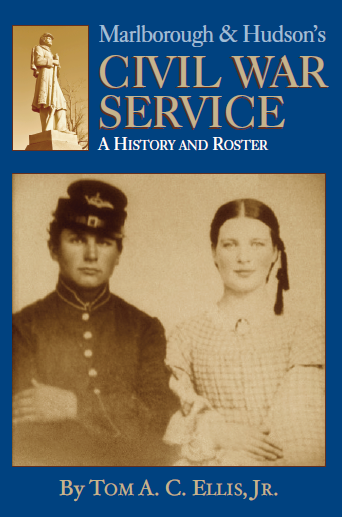Marlborough/Hudson’s Civil War history and service records were destroyed on December 25, 1902, when the Town Hall burned to the ground. Fortunately, through research, they have been recreated and chronicled in this book. The information was gleaned from: Massachusetts Adjutant General Schouler’s reports, Ella Bigelow’s Historical Reminiscences, Cyrus Felton’s writings, Lewis Halprin’s images, Charles Hudson’s writings, Clement Mesereve’s County histories, cemetery records, Marlborough’s History 1661-1910, U.S. Census records, Federal Emergency Relief Admin. Project 1933-38, and numerous military regimental histories.
The pragmatic people of Marlborough/Hudson displayed their contempt for slavery 13 years before the Civil War. They held a “Free-Soil Meeting” in 1848 with over 800 attendees. In 1850, they voted, “not to aid… resist” the Fugitive Slave Law. In 1859, they invited known abolitionist, Reverend Henry Ward Beecher, to give a series of lectures in the Town Hall. They called for an “Indignation” meeting when John Brown was executed.
On April 12, 1861, General P.G.T. Beauregard began three days of shelling Fort Sumter, at the tip of Charleston Harbor, South Carolina. April 15, 1861, President Lincoln called for 75,000 militia soldiers for three months to quell the unlawful insurrection. The ire and indignation of the town was aroused. On April 16, 1861, David H. Ball and Charles Morse raced from Marlborough to Boston, and enlisted in the 6th Mass. Vol. Militia. As the 6th Mass. passed through Baltimore, it was attacked by a mob. An ardent spirit of patriotism swept the town. On April 19, 1861, Edward Ingraham and Patrick Kenna rushed from Marlborough to Worcester and enlisted in the 3rd Battalion of Rifles for three months.
The earliest a legal town meeting could be held was April 29, 1861. A meeting was held on that date and a war committee of ten men was established. Thus, began a process that Marlborough/Hudson would use for the duration of the war.
A Biographical Roster starting on page 346, lists 1,033 men whose service was accredited to Marlborough/Hudson. It delineates their military service, birth, death, parents’ names (including mother’s maiden), burial place and other notable accomplishments when information was available. The Cemetery section starting on page 129 includes another 278 men that were Civil War Veterans that moved from other municipalities they served for. They chose Marlborough/Hudson as their final resting place and they are also honored in this book.
Marlborough/Hudson served in almost 75% of all organizations organized by Massachusetts. Seventy-six men would be killed as a result of battle, 49 more would die of disease, 68 would become prisoners of war, 178 would be wounded in battle, and 222 would become disabled and were discharged for their disabilities.
Every black organization formed by Massachusetts, was served by Marlborough/Hudson men, as well as National U.S. Colored Regiments. The women of these towns formed Soldiers’ Aid Societies. They organized sewing circles known as Ladies’ Benevolent Societies. They did much more to comfort soldiers and their families.
Marlborough/Hudson surpassed all duty required of her for the preservation of our Nation in the Great War of the Rebellion, at the seat of war, and on the home front. It is this book’s intention that her resolute service never be forgotten.
